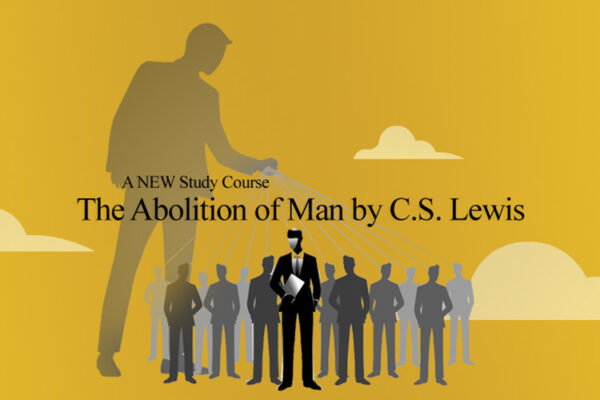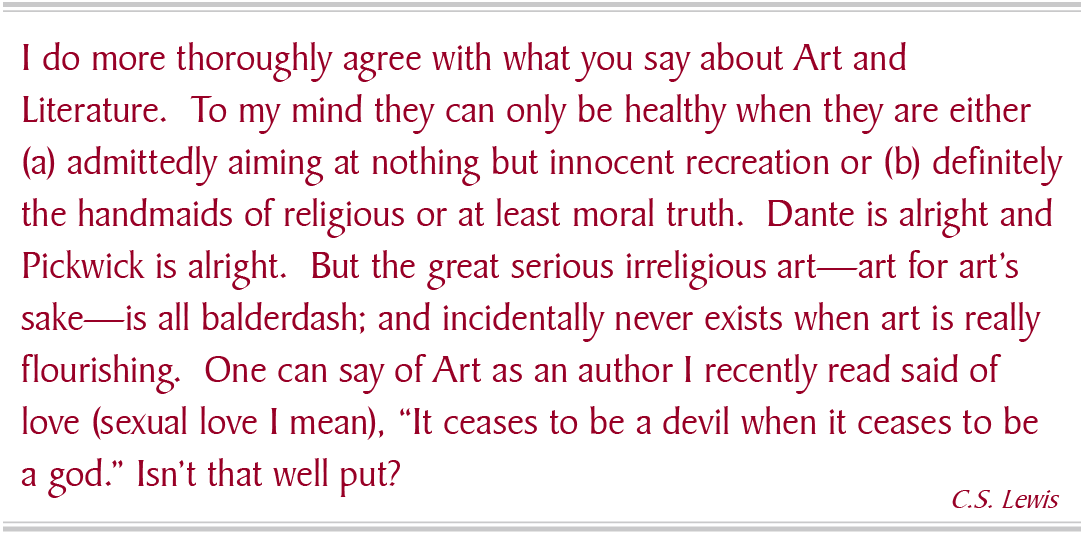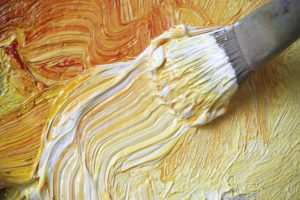Back to series
John Calvin and the Visual Arts:
Calvin: The Nemesis of Visual Arts?
Calvinism: Disparaging the Senses?



John Calvin and the Visual Arts:
Dueling Cavaliers?
Click here to open a Print - Friendly PDF
Have you ever had a war take place inside your head? Imagine two conflicting forces, each claiming to be truth and each stubbornly refusing to bow to the other. In my mind, there has been such a standoff. Like those who are about to engage in a duel, these two forces have taken their ten paces, turned around, and have aimed their pistols at each other. Who are these cavaliers? They are not living people but caricatured images of John Calvin and Reformed thought on one hand, and the stereotypically flamboyant Artist and the entire world of visual arts on the other.
On the Calvinist side (this in my mind’s eye; please, take no personal offense!) we find restrictive, restricted, repressive, reformed religion. The walls of churches are white washed, bare and blank, matching the surrounding faces. The stiff figures look right at home—as if part of the architecture—sitting on the hard, straight-backed wooden benches. Their lips are tightly pursed while clenched hands sit firmly on cold laps.
On the other side dances the wildly unorthodox, mystical, mysterious, exasperating, and exhilarating Artist. This composite composer is a combination of Caravaggio, who painted the sumptuous Bacchus, and Monet, who rendered his Water Lilies. There is a bit of Picasso flaunting his fractured Demoiselles D’Avignon and Jackson Pollock running around, splashing erratic color.
Is there any hope for reconciliation between these seemingly opposed forces? Can the two dueling sides ever come together? Is there, in fact, maybe at the root of this battle, a gross misunderstanding? Could Calvin and “Visual Arts” actually be friends? Those more familiar with Reformed thought might instantly assert a definitive yes. But for many, resounding affirmation is not the first imagined response of the father of Reformed thought when asked about space in his (and his legacy’s) thinking for the visual Artist and his or her creation. So if we are going to avoid a potentially disastrous explosion inside my head (and I would love to do so), then it is worth taking a closer look.
Back we must go to the original sources to understand this image of Calvin, the seeming foe of visual arts. We must travel back to sixteenth-century Geneva, Switzerland, to the office of one pastor, teacher, preacher, and theologian: John Calvin. His brow furrowed in concentration, he puts his pen to paper and begins to write: “It Is Unlawful to Attribute a Visible Form to God, and Generally Whoever Sets up Idols Revolts against the True God.” Thus begins chapter 11 of the first book (“The Knowledge of God the Creator”) of his Institutes of the Christian Religion.1 And there begins what seems to some like a short circuit in the connection between Reformed Christianity and the visual arts.
Calvin: The Nemesis of Visual Arts?
Aside from a short paragraph on “The functions and limits of art,” the bulk of Calvin’s words about art have to do with the images of God that are used in worship. Calvin essentially lays out a defense for the iconoclasm practiced by sixteenth-century Protestants everywhere. “Ha!” one-half of my brain says, “Calvin was anti visual arts after all. If he wrote to support the destruction of beautiful images, religious art even, he was obviously an aesthetic nit-wit with an axe to grind toward those who were more creative and more sensuous than himself.” But perhaps that brain half needs to relax for a moment, suspending judgment until the whole story is told.
Calvin wrote as he did against images within a context of image misuse and abuse in the late medieval church. If we want to understand his story, we need to go back further, this time to the world of Gothic cathedrals, filled with candles and crucifixes, smells and bells, statues of saints, paintings of popes, altars of gold. This is the world that the medieval Christian knew as the center of culture, the heartbeat of Christendom.
 In his book Zwingli and the Arts, Charles Garside describes the experience of entering the cathedral in Zurich (prior to the iconoclastic activities of the reformer Zwingli):
In his book Zwingli and the Arts, Charles Garside describes the experience of entering the cathedral in Zurich (prior to the iconoclastic activities of the reformer Zwingli):
. . . the pilgrim was prepared symbolically on entering the chapel, since over the portal leading down into it was a wall painting of Christ standing in the tomb with instruments of His passion on either side. Once the pilgrim had descended, he would have seen a wooden sepulcher under a canopy supported by pillars, likewise of brilliantly painted wood. Surround the sepulcher were large wooden statues of Mary Magdelene, Mary and St. John, while wrapped in a white coverlet with silken tassels, was laid a wooden replica of the body of Christ, which was removed (through a hole in the vaulting contrived especially for the purpose) from the grave on Easter Sunday.2
Simply entering the church meant encountering an image extravaganza. Everywhere the Christian looked, there were saints and Christ images staring back. (“Ah,” says half my brain, “I’d love to contemplate all that beauty.”)
The medieval Christian, however, did more than simply contemplate these objects as we might do today in a beautiful home or an art museum, letting the “feel” soften or even instruct our hearts. The medieval Christian spent much of his or her time in faithful veneration before these images. Veneration meant giving honor to the saint (or worship to the Christ) whose reality existed behind the painted or sculpted image. So a Christian might come in off the street and light a candle in front of a particular crucifix (there were seventeen altars to choose from in the Zurich cathedral3), knowing that his homage rested not on the gold, stone, wood, or pigment out of which the image was created. Rather his praise and prayer went up to heaven, invoking (via the saints, Mary, or Christ) the good grace of God. Thomas Aquinas put it this way: “Religion doesn’t offer worship to images considered as mere things in themselves, but as images drawing us to God incarnate.”4
Trouble, however, started just at this point. As Scripture was unavailable in the vernacular (which actually made little difference, as the majority of people were illiterate), and as services—except for the sermon—were conducted primarily in Latin, most people missed the subtle distinction between worshiping/honoring the prototype and worshiping/honoring the graven image. As a result, images in churches came to be not only beautiful objects that could lift the mind and heart toward a focus on the beautiful Creator; they became power sources that the good Christian should tap for grace. Even the Eucharist need not be understood; one must simply get a look at the host to receive a healthy portion of God’s grace.5

Such is the context into which Calvin writes. And write he does. His attack on images (specifically images of God that were used in worship) emerges not as a direct attack against the visual arts, but against the idols that he believes have taken God’s place. His argument is clear and simple: People want to control God, so they “reduce God, who is immeasurable and incomprehensible, to a five-foot measure.”6 The visual image becomes a dumb icon whose grace is invoked at human bidding. No one need wait upon the true Giver of grace, the triune God. Such an understanding of images, said Calvin, teaches “insipid fiction”7 about God—that God is at humanity’s bidding and not the other way around. This, contends Calvin, infringes upon God’s glory: “Images are unworthy of God’s majesty because they diminish the fear of him and increase error.”8
At this point, though, the artist within me aches to ask, “Couldn’t images be put in their proper place, as objects of contemplation, and not be given ‘idol’ status?” Calvin concludes no. Not only are images problematic because people have abused them and thereby dethroned God, but images of God are, he argues, implicitly idols, the product of deceitful hearts: “The mind begets an idol,” says Calvin, “the hand gives it birth.”9 That is why, Calvin contends, God said, “You shall make no graven images” (Exod. 20:4). Romans 1 says our nature is to be idolatrous, so if images are there, people will inevitably worship them. The best bet, insists Calvin, is to rid one’s heart of the images and, in obedience to God’s commands, do away with all the visual depictions that might be deemed implicitly idolatrous. (As an aside, this is where John Calvin and Martin Luther differed: Luther emphasized that idolatry is solely a heart issue; one can make an idol out of anything that is good [e.g., one’s spouse], but that does not mean we should eliminate that object or person. And though I tend to agree with Luther, I cannot help but recognize that in some way Calvin seemed to understand the undeniable power of sensuous images to affect the heart; the artist in me knows he is right in this.)
Convinced then that visual images of Jesus Christ in particular are inextricably linked with false understandings of God, Calvin nevertheless reminds us that not every visual image need be eliminated. Toward the end of chapter 11, Calvin forwardly declares:
I am not gripped by the superstition of thinking absolutely no images permissible. But because sculpture and painting are gifts of God, I seek a pure and legitimate use of each, lest those things which the Lord has conferred upon us for his glory and our good be not only polluted by perverse misuse but also turned to our destruction.
Perhaps then Calvin was not so much an oppressive aesthetic nit-wit, as he was a pastor concerned for the freedom of heart and the right grasp of grace for all of his parishioners.10
Calvinism: Disparaging the Senses?
Pondering these insights together, the two cavaliers inside my mind stare at each other long enough to almost smile, but then . . . the Artist cries out, “Wait just one minute! So perhaps you make a decent case for not painting images of Jesus Christ, and perhaps you have pastoral inklings—but in your Institutes, Calvin, you speak in high, aloof words about an immutable, ineffable God.
 You seem like a cold Platonist. Do you know what it is to be a human? Do you value what it is to sweat or smile or cry or drink a glass of wine? If you don’t value these things, how could you ever value life as embodied in sculpture or painting? What is this ‘pure and legitimate use’ of which you speak, anyhow? Is it a cold utilitarianism: for those who cannot read words, give them images? Does this life’s sensuous beauty and its related pleasure have any intrinsic value?”
You seem like a cold Platonist. Do you know what it is to be a human? Do you value what it is to sweat or smile or cry or drink a glass of wine? If you don’t value these things, how could you ever value life as embodied in sculpture or painting? What is this ‘pure and legitimate use’ of which you speak, anyhow? Is it a cold utilitarianism: for those who cannot read words, give them images? Does this life’s sensuous beauty and its related pleasure have any intrinsic value?”
Admittedly, Calvin does emphasize that God is an “incompressible essence”11 (and obviously that would not lend itself toward a visual depiction), and he does declare that “the best way to contemplate the divine is where minds are lifted above themselves with admiration.”12 God is for Calvin undoubtedly greater than we can ever understand. But contrary to what the Artist within wonders so vehemently, in both the content and the language of his writing Calvin seems to celebrate the immanence of God. In his preface to The New Testament he writes:
The little singing birds are singing to God; the beasts cry unto Him; the elements are in awe of Him; the mountains echo His name; the waves and the fountains cast their glances at Him; grass and flowers laugh out to Him. Nor indeed need we labor to see Him, afar, since each of us may find Him within himself, inasmuch as we are upheld and preserved by His power dwelling within us.13
Clearly Calvin understands both the nearness of God and the joys of His very sensuous creation. And in his word choice and use, we see an understanding of what it means to celebrate beauty: his images are vivid, alive, and full of wonder and delight. Historian John McNeill puts it this way: “While his thoughts flow, the words in which he clothes them are chosen with a trained sense of artistic fitness.”14 Calvin really does believe in the value of visual beauty, not simply the beauty of well-crafted words, a meek spirit, or a changed heart. Thus, in one of his most famous passages about the gifts of God in His creation, he writes:
Has the Lord clothed the flowers with the great beauty that greets our eyes, the sweetness of smell that is wafted upon our nostrils, and yet will it be unlawful for our eyes to be affected by that beauty, or our sense of smell by the sweetness of that odor? . . . Did he not so distinguish colors as to make some more lovely than others? . . . Did he not endow gold and silver, ivory and marble, with a loveliness that renders them more precious than other metals or stones? Did he not, in short, render many things attractive to us, apart from their necessary use?15
A Reformed Vision of the Visual Arts?
The Artist in me begins to exhale.
Calvin, it seems, neither denigrates the senses nor disparages images (with the exception of those he sees as having become idolatrous). Rather, he values the place of beauty, including its nonutilitarian expressions. True, he does not develop his concept of the “pure and legitimate” use of art. But in fairness, he wrote his Institutes in defense of the faith for which many of his close friends had been killed, to “vindicate from undeserved insult my brethren whose death was precious in the sight of the Lord.”16 He did not write as a contemporary philosopher of art or as the chief curator of the National Gallery of Art.
And so the Artist and Calvin stare quietly at each other, each exhaling. Perhaps, as the Artist recognizes, Calvin has his own story and even makes some good points. So with much less hostility, and a fair dose of humility, the Artist asks, “Um, any suggestions about how I might think of the visual arts?” And with equal humility Calvin replies: “No, not beyond that which I have already offered. But as our sovereign God would have it, many thinkers in my footsteps have articulated a vision of the visual arts that just might help us put down our pistols for keeps.”
Both of their eyes slowly light up; they begin to talk, and this is where the story starts to get really interesting.
Part Two: A Reformed Vision of the Visual Arts: A conversation with Abraham Kuyper, Nicholas Wolterstorff, C.S. Lewis, and, most important, the Word of God.
Notes:
1. John T. McNeill, ed., Calvin: The Institutes of the Christian Religion (Philadelphia: Westminster, 1960) I.11.1.
2. Charles Garside, Jr., Zwingli and the Arts (New Haven, CT: Yale University Press, 1966), 89.
3. John Dillenberger, A Theology of Artistic Sensibilities (New York: Crossroad, 1986), 68.
4. Carl C. Christensen, Art and the Reformation in Germany (Athens: Ohio University Press, 1986), 68.
5. Margaret R. Miles, Image as Insight: Visual Understanding in Western Christianity and Secular Culture (Boston: Beacon Press, 1985), 98.
6. McNeill, Calvin: The Institutes I.11.4.
7. Ibid.
8. Ibid., I.11.2.
9. Ibid., I.11.8.
10. Ibid., I.11.12.
11. Ibid., I.11.3.
12. Ibid.
13. John McNeill, Calvinism, 230.
14. Ibid., 231.
15. McNeill, Calvin: The Institutes, xxxii.
16. Ibid.

Connally Gilliam
SpeakerConnally Gilliam, Speaker, has been serving around the world with the US Navigators, through her speaking, writing and mentoring, Connally addresses questions surrounding singleness, sexuality, gender, loss and race. She is author of the best-selling book, Revelations of a Single Woman: loving the life I didn’t expect and co-author, with Paula Rinehart of And Yet, Undaunted: Embraced by the Goodness of God in the Chaos of Life. Connally holds both a BA and MT in English from the University of Virginia and her MA in Theological Studies from Regent College (Vancouver, BC), where she also serves on the Board of Governors.

 COPYRIGHT: This publication is published by C.S. Lewis Institute; 8001 Braddock Road, Suite 301; Springfield, VA 22151. Portions of the publication may be reproduced for noncommercial, local church or ministry use without prior permission. Electronic copies of the PDF files may be duplicated and transmitted via e-mail for personal and church use. Articles may not be modified without prior written permission of the Institute. For questions, contact the Institute: 703.914.5602 or email us.
COPYRIGHT: This publication is published by C.S. Lewis Institute; 8001 Braddock Road, Suite 301; Springfield, VA 22151. Portions of the publication may be reproduced for noncommercial, local church or ministry use without prior permission. Electronic copies of the PDF files may be duplicated and transmitted via e-mail for personal and church use. Articles may not be modified without prior written permission of the Institute. For questions, contact the Institute: 703.914.5602 or email us.
-
Recent Podcasts
Ralph Waldo Emerson’s Philosophy and Influence
by David George Moore on July 26, 2024Ralph Waldo Emerson was a gifted nineteenth century...Read More
-
The Side B Stories – Nate Sala’s Story
by Jana Harmon, Nate Sala on July 19, 2024
-
Terrorism Through the Eyes of Faith
by Dennis Hollinger on July 12, 2024
-
Recent Publications
Hasn’t Science Proven That Belief in God Is an Outdated Superstition?
by Sharon Dirckx on July 1, 2024Many assume that scientific practice and belief in...Read More
-
Has the Bible Been Corrupted as Some Muslims Claim?
by Andy Bannister on June 1, 2024
-
Seeing Jesus Through the Eyes of Women
by Rebecca McLaughlin on May 15, 2024
0
All Booked
0.00
All Booked
0.00
All Booked
22194
C.S. Lewis’s The Abolition of Man Live Online Small Group 8:00 PM ET
https://www.cslewisinstitute.org/?event=c-s-lewiss-the-abolition-of-man-study-course&event_date=2024-10-02®=1
https://www.paypal.com/cgi-bin/webscr
2024-10-02

Next coming event
Days
Hours
Minutes
Seconds
C.S. Lewis’s The Abolition of Man Live Online Small Group 8:00 PM ET
On October 2, 2024 at 8:00 pmCategories
Speakers

Connally Gilliam
Speaker
Team Members

Connally Gilliam
SpeakerConnally Gilliam, Speaker, has been serving around the world with the US Navigators, through her speaking, writing and mentoring, Connally addresses questions surrounding singleness, sexuality, gender, loss and race. She is author of the best-selling book, Revelations of a Single Woman: loving the life I didn’t expect and co-author, with Paula Rinehart of And Yet, Undaunted: Embraced by the Goodness of God in the Chaos of Life. Connally holds both a BA and MT in English from the University of Virginia and her MA in Theological Studies from Regent College (Vancouver, BC), where she also serves on the Board of Governors.





